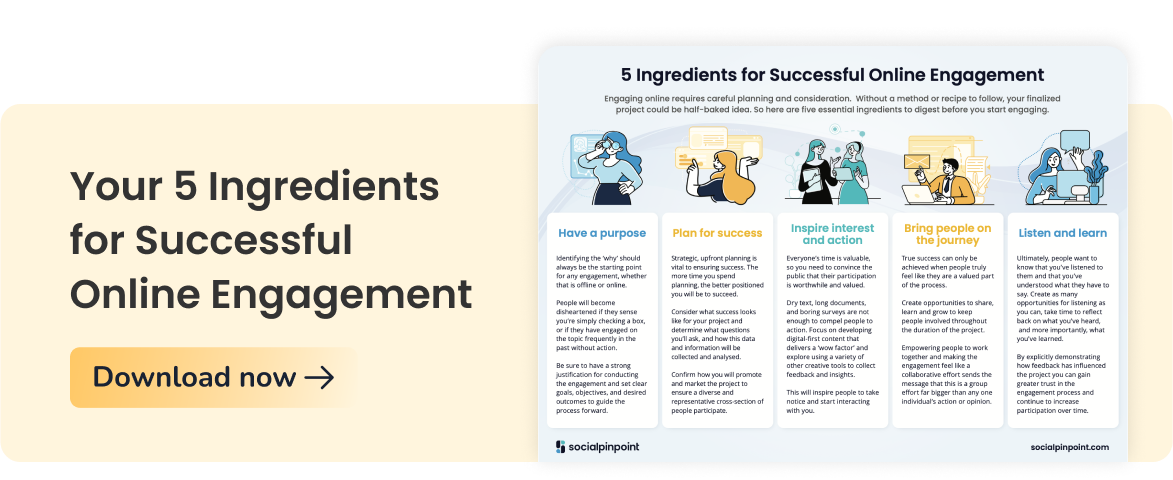Those who are critical of digital community engagement are usually critical of digital community engagement done wrong. This is when digital community engagement is just regular business-as-usual, tick-box engagement. Generally, this type of engagement is not driven by strategy or planning and fails to reach anyone beyond the same old NIMBY audience. So, how can you move away from routine and set yourself up for digital engagement success?
The risks of conducting poor digital engagement are clear: failure to extend your organization’s reach, influenced or hijacked processes, biased data collection and outcomes, additional cost and effort, and ultimately the reinforcement of community apathy or distrust in government.
In some cases, digital community engagement is chosen out of administrative convenience, with a lack of creativity and inspiration and limited understanding of data collection and use.
Rather than dwell on why poorly executed digital community engagement fails, we want to shine a light on how it can succeed, with the right combination of planning, strategy, communication, and analysis.
And, with an abundance of incredible, digital engagement tools now available to broaden your success, digital community engagement can be done right.
In this article, we will cover our top 5 principles for digital engagement success.
1. Have a purpose
Have a clear intent as to why you are engaging in the first place. Are you just checking a box, is there a demonstrated need, or have you done it before? Ask yourself if you have clearly defined goals and desired outcomes, and a vision for how input for your community will help to share and evolve the project.
This means setting objectives to create better projects, programs, policies, and strategies. In action, it means a considered approach to the planning of content, and to data collection and analysis.
Develop strategies to unlock insights and knowledge from the data you collect from your community. From the very start, create explicit links between the design process and decision-making.
2. Plan for success
This step provides the blueprint to guide interactions in a well thought out and integrated way.
From the beginning, you should know what you need to collect, how you’ll collect it, and how you’ll use it.
What do you need to ask, how are you going to ask it, and when will you go back to the community with what you’ve discovered?
Provide a variety of ways for people to be involved and promote, promote, promote! Set targets for representation so that you can go beyond the ‘usual suspects’ and ensure confidence in the robustness of your data.
Create pathways for constructive and positive interactions with your community, putting yourself in their shoes so you can create user-friendly, compelling experiences that provoke a response.

3. Inspire interest and action
Before asking for something, always articulate the value for participants.
Why should they give you their precious time and insights? Why should they care? Encourage positivity and constructive action.
When you are setting up your online projects, create compelling content and communications that grab people’s attention and pull them into the conversation. Above all, you should make participating enjoyable – that could mean making activities fun, meaningful, or even challenging!
4. Bring citizens on the journey
Bringing people along on the journey means engaging and communicating information early on and often in a project. This is important as it means constant re-engagement, building trust, and giving people a sense of agency and investment in the project.
Provide the materials to educate and build capacity within the community, fostering involvement and community spirit. Bring people into contact with others with different views and build relationships between citizens.
Communicate back regularly (close the loop), and accurately and honestly reflect back the community’s views in your final outputs.
5. Show you listened and learned
By showing you’ve listened and demonstrating how people’s input will help shape decisions or changes, you will build trust and grow the relationship between community and government. Community engagement projects should probe the underlying values of the community, identify priorities, and seek solutions.
Throughout the process, listen to people’s experiences and stories, source ideas and content to feed back into the process, do thorough and thoughtful analysis to corroborate your findings, and then reflect what you heard back to the community. Finally, invite people to future opportunities and keep the conversation going.
Online engagement is complex and following these five principles is no guarantee of success. However, by embedding these principles in your day-to-day you can approach your digital community engagement projects with a solid framework that can ensure integrated campaigns, content-rich, interactive, branded experiences, and data-driven design and decision-making.












